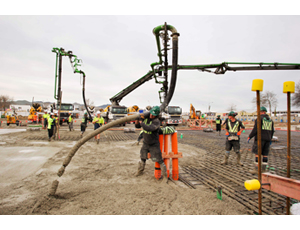
Earthquake-hit Christchurch, New Zealand’s second most populous city, on Sept. 23 celebrated a major milestone in its rebuilding with a successful 1,428.6-cu-meter concrete pour for the base of a major new transportation facility. The single placement is the largest of its kind ever performed on the South Island.
In 12 hours, 234 ready-mix trucks discharged the concrete for the base of the city’s new $43-million bus station, one of the city’s "anchor projects" given priority by the Christchurch Earthquake Recovery Authority. The facility forms a 14,000-sq-m block bounded by Sol Square, Tuam, Colombo and Lichfield streets in the Central Business District.
New Zealand's Allied Concrete delivered the majority of the ready-mixed concrete in just seven and a half hours of the total 12-hour operation.
“The average return trip time was 76 minutes per truck. Considerable resources were applied to the task," says Dave Barker, Allied director. "The first load was batched at 2:06 in the morning, and 1,410 cubic meters of the total was delivered by 9:30 a.m."
The station is being constructed under a $32.5-million joint venture between Australian company Thiess and Christchurch's own Southbase Construction.
Warwick Isaacs, Christchurch Central Development Unit director, says this concrete pour is a significant moment for the city's rebuild.
"We are very excited that this pour will result in the bus interchange beginning to take shape," he says. "The task creates the foundation slab for building the Lichfield Street frontage. It consists of a 90-centimeter-deep slab on the 90-meter by 160-meter site." Structural-steel erection began in October.
The building is L-shaped and naturally divides into two, says Gordon McGregor, the joint venture's project manager. "The large pour was for the foundation raft of one leg of the building. We have a challenging program, and while we could have poured the raft in sections, we decided to go for it in one," he says.
Three concrete pumps placed the 4,350-psi mix in three 300-millimeter layers. "Effectively, we made three passes to complete the slab. This enabled us to control placing and slightly reduce the hydration heat,” says McGregor.
The superstructure of the bus interchange will be highly visible by the end of October, and the entire building is expected to be operational in 2015. With the main entrance off Colombo Street, the station will have 16 bays capable of handling more than 100 buses an hour, as well as indoor waiting areas, taxi stands, a covered lock-up facility for 100 bicycles and secure public lockers.
"Planning for future development has also been taken into consideration, with the slab being designed to withstand the possible construction of a three-story structure being built atop the bus interchange," Isaacs says.
While this is the largest continuous concrete pour on an anchor project, it will not be the biggest slab to be laid. The Justice and Emergency Services Precinct, when completed, will have the largest main slab for an anchor project, amounting to about 9,600 cu m.

Post a comment to this article
Report Abusive Comment